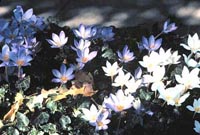Resource Library
Plant of the Week: Autumn Crocus
The University of Arkansas System Division of Agriculture does not promote, support or recommend plants featured in "Plant of the Week." Please consult your local Extension office for plants suitable for your region.
Plant of the Week
Autumn Crocus
Latin: Crocus speciosus

On the same day that America received the horrific surprise from the Middle East, the postman delivered a package that had begun its travels from the same part of the world centuries ago. The corms the postman delivered that fateful day were Crocus speciosus, the Autumn crocus.
These corms had followed the path of many immigrants, first stopping off in Holland before making their way to our shores.
The Autumn crocus is one of a dozen or more fall-flowering crocuses grown in American gardens. The light blue to violet flowers begin appearing in late September and October and grow 6-8 eight inches tall without a trace of foliage. The flowers are typical of crocus, with six petals, or tepals, forming a narrow tube that extends into the earth.
Perhaps it’s a testimony to the harshness of the climate in Turkey, Iran and the mountains of Afghanistan that have kept the womb of the flower, the ovary, below ground. The unpredictable and harsh winter weather can appear early, so the plant has developed the survival strategy of maturing its capsule of seeds below ground and out of the reach of all but the hardest freezes. As the seed ripens, the peduncle elongates and the pods emerge to the surface of the soil.
The fall-flowering characteristic of Autumn crocus is also an adaptation to the harsh climate. Plants blooming in the fall without a trace of leaves usually hail from regions that have prolonged summer droughts. The leaves of Autumn crocus are typical for crocus and appear early in the spring and persist until the heat of summer broils them into submission.
The corm, an underground storage structure constituting a solid, white starchy mass with the buds embedded on the surface in concentric rings, is typical of other members of the iris family such as gladiolus, except for its size. While often referred to as a "bulb" in the jargon of the gardener, it lacks the internal scales seen in onions, daffodils and other such true bulbs.
The name Crocus is from the Greek word krokos, which was borrowed from the Semitic word karkom. The name did not refer to the familiar spring-blooming species, but to the Saffron Crocus (C. sativus), which was used extensively as a die, as an ingredient in cooking and even in embalming rituals.
This plant, so widely sought after in its Mediterranean homeland by the ancients, is now known only in cultivation. It’s been harvested to the point of extinction in the wild.
Of the fall blooming crocuses, C. speciosa is perhaps the showiest. It should be planted 4-6 inches deep in well prepared, deeply spaded soil. While most crocuses do best in full sun, this species seems to do best in the high shade of oak trees.
While the plant is from a dry, hostile region, it seems to flourish best in a moderately moist site. In the Southern garden, they will increase slowly and eventually naturalize, making them valued citizens of the League of Nations that make up our own gardens.
It can be used in the front of mixed borders as an addition to the lawn or in groundcover beds. At least to my eye, these naked-fall flowering plants look gawky and strange if they’re emerging in open ground. A skirt of grass or vinca leaves gives the blooms a point of reference and more effectively displays their delicate beauty.
By: Gerald Klingaman, retired
Extension Horticulturist - Ornamentals
Extension News - September 28, 2001
The University of Arkansas System Division of Agriculture does not maintain lists of retail outlets where these plants can be purchased. Please check your local nursery or other retail outlets to ask about the availability of these plants for your growing area.